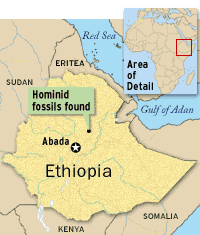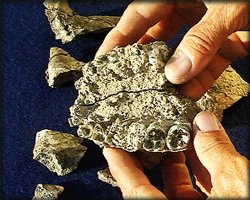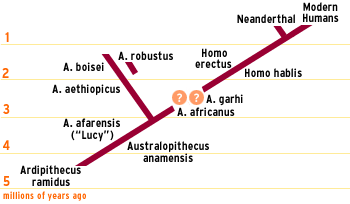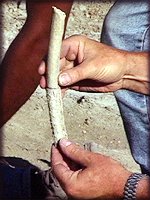By Kenneth
Chang
ABCNEWS.com
April 22 — Two and a half million years ago near a lake in Ethiopia, a humanlike
creature raised a stone and smashed it down on an antelope bone to get at the marrow and
fat inside.
The hominid is long gone, but the broken antelope bone remains,
the earliest known evidence of a stone tool used to butcher an animal.
Bones of Contention
Nearby, two other hominids, of roughly the same era, died. Arm and leg bones of one
individual — probably less than 5 feet tall — survived to the present, but no
teeth or skull. For the other one, pieces of the skull fossilized, but not the rest of the
skeleton.
All that can be said for certain is that the three hominids were
at the same place at almost the same time. Scientists can’t say yet whether the skull
belongs to the same species as the leg and arm bones, or which type of hominid pounded
open the antelope bone.
 |
 |
| The latest hominid
fossils were found in Ethiopia’s Afar desert. (ABCNEWS.com) |
Still, these tidbits are the first significant clues of the
hominids that lived in eastern Africa during the epoch when apelike creatures evolved into
the predecessors of modern-day humans.
“It is our best candidate yet for a direct ancestor [from
this time period],” says Owen Lovejoy, a professor of biomedical sciences at Kent
State University in Ohio and one of the researchers. “Now that it’s there at 2.5
million, we’re faced with this animal that is at the right place at the right time to
be a lineal ancestor of modern man.”
The discoveries, uncovered by an international team of 40
scientists, are reported in two articles in Friday’s issue of the journal Science.
From Ape to Man
Before 3 million years ago, a string of apelike creatures culminated in the
upright-walking Australopithecus afarensis, the best known of which is the
“Lucy” skeleton. The earliest members of our genus, Homo, emerge about 2
million years ago.
In the intervening 1 million years, the story of human evolution
is fuzzy. A changing climate thinned the forests where the apelike creatures lived,
spurring a burst of evolution as animals adapted to life on the expanding savannahs.

One surprise in the A.
garhi skull was the enormous back teeth, instead of smaller ones seen in later Homo
species. (Video Image/UC Berkeley)
|
“You go into this period with, in essence, bipedal big-toothed chimps and come out
with meat-eating, large-brained hominids,” says Tim White, the University of
California, Berkeley, anthropologist who co-lead the research. “That’s a big
change in a relatively short time. We’d really like to know more about what happened
there.”
One branch of the hominid family known as robust
australopithecines evolved huge teeth to chew on the tough plants of the plains.
They’re clearly not ancestors of Homo, and eventually died out.
 It's not yet clear whether A.
garhi falls on the direct lineage leading to modern humans, or lies on an extinct
branch. (ABCNEWS.com) It's not yet clear whether A.
garhi falls on the direct lineage leading to modern humans, or lies on an extinct
branch. (ABCNEWS.com)
|
A more promising candidate for human ancestry is Australopithecus
africanus with its more human-looking face. But that species, first appearing around
2.8 million years ago, has only been found in South Africa, far away from the birthplace
of the earliest Homo in East Africa.
Many anthropologists expected fossils of A. africanus
would eventually show up in the East African sediments as well.
Not What They Were Looking
For

The hominid’s thigh
bone is relatively long compared to earlier hominids — more like a human. (Video
Image/UC Berkeley)
|
Instead, they found A. garhi, a species name assigned to the
newly described skull. In the local language, garhi means surprise.
The skull of A. garhi looks very different from A.
africanus, surprisingly primitive with a protruding apelike face. “The garhi
is very much a scaled-up afarensis,” White says, “except its brain
doesn’t scale up.”
The braincase of A. garhi is only 27 cubic inches, less
than a third of the 85-cubic-inch braincase of humans.
The arm and leg bones of the second hominid are also surprising.
Compared with the earlier Lucy, the thigh bone has lengthened to more humanlike
proportions, but the upper arm retained a long, apelike appearance.
Food-Driven Evolution
The mangled antelope bone shows the hominids of Ethiopia, probably scavengers, not
hunters, had added high-nutrition marrow to their diets. Many anthropologists hypothesize
that this change of diet spurred the development of stone technology and the evolution of
larger, presumably more intelligent, brains.
“You as a bipedal hominid, you’ve sacrificed your
ability to move around very quickly,” White says. “And you’re going out to
very open habitats where there are big predators — saber-toothed cats, hyenas —
and not only are you going out there, you’re going out there to compete with these
animals for the food resources. You have a very good chance of ending up as food yourself.
That’s the strong selective pressure. That could, of course, drive evolution very
rapidly.”
The simplest interpretation of the data is that the second fossil
and the hominid who smashed the antelope bone were also A. garhi. But White says
there’s not enough evidence to say that interpretation is the correct one.
Confused Genealogy
It will also take some time and more fossils to determine A. garhi’s place in
the family tree. It may be a direct ancestor of humans, and A. africanus is a
dead-end branch. Or vice versa. Or maybe both are dead ends and the true ancestor remains
undiscovered.
For George Washington University anthropologist Bernard Wood, the
discovery fits in with his expectations that several different species evolved —
“a series of experiments” — in response to the changing environment.
“Many of us actually don't think it was a surprise,”
Wood says. “We ought to throw away the notion that every time we find a new sort of
hominid that it must be on the line leading to modern humans What we’re looking at is
not an evolutionary ladder; it’s an evolutionary bush.”
A. garhi is for now just another branch on that bush
— one that just may be a root of all humanity. 

|
 |
S U M M A R
Y

A hominid that lived 2.5 million
years ago in Ethiopia’s Afar desert might have been an ancestor of modern humans.
“We’re faced with this animal that is at the right place at the right time to be
a lineal ancestor of modern man.”
Owen Lovejoy,
researcher
|


